Puget Systems Serenity SPCR Edition: Blissful Silence
by Dustin Sklavos on February 10, 2011 12:00 AM EST- Posted in
- Systems
- Intel
- Radeon
- Sandy Bridge
- Puget Systems
- Serenity SPCR
Application and Futuremark Performance
At this point it goes without saying that Sandy Bridge is fast, but this time around we have a stock-clocked system contending with both an overclocked Sandy Bridge unit and quite a few systems featuring some overclocked representatives of last generation's finest. While you're looking at these benchmarks, though, try to remember that Puget Systems tuned the Serenity SPCR Edition for maximum silence. The Intel Core i5-2500K hasn't been touched, and the PowerColor Radeon HD 5750 included is tied for the fastest passively-cooled video card on the market. You can hear all of the other systems here under load, but you can't hear the Serenity.
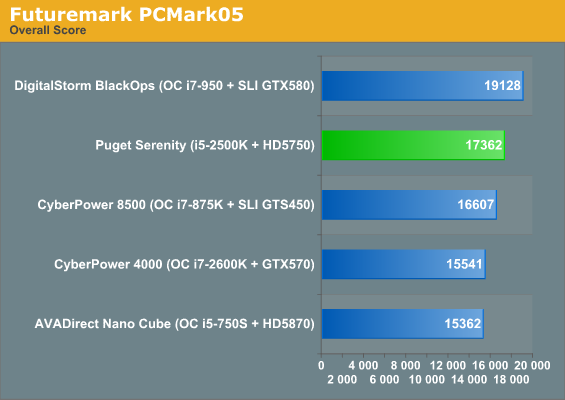
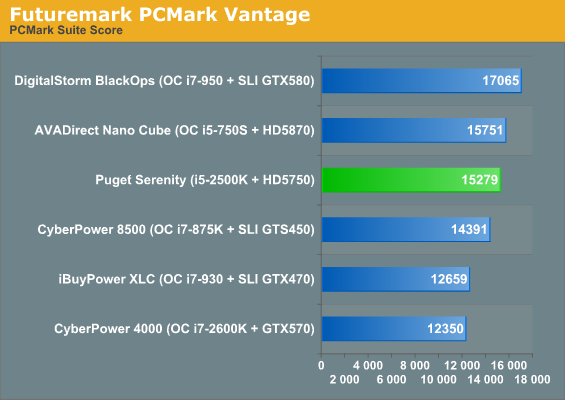
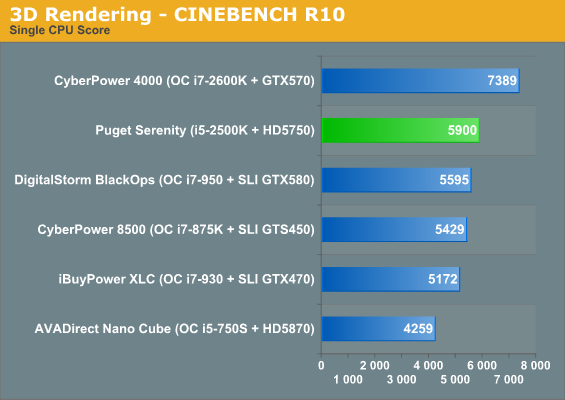
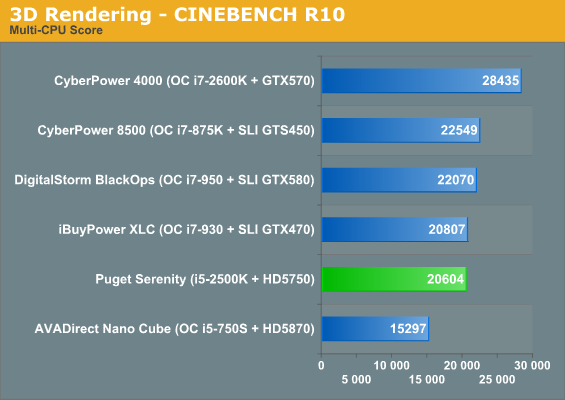
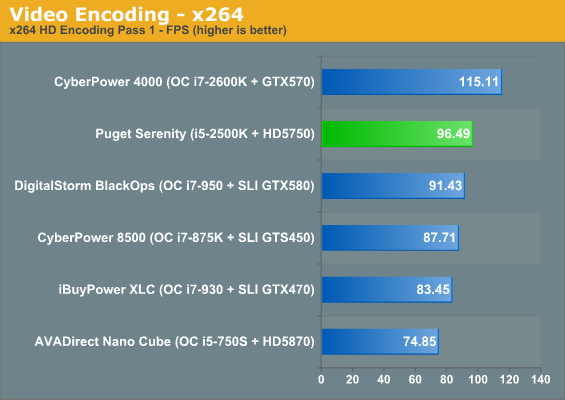

As you can see, even at stock clocks with no Hyper-Threading, it still takes a lot to hold Sandy Bridge down. The DigitalStorm and CyberPower 8500 systems are both running their processors at 3.8GHz, and DigitalStorm's tower has the added benefit of triple-channel memory. In fact the only chips that aren't Hyper-Threaded are the i5-2500K and the i5-750S, and while the i5-750S basically trails the competition here, the i5-2500K's worst showings still mostly nip at the heels of the 3.5GHz processor inside the iBuyPower XLC.
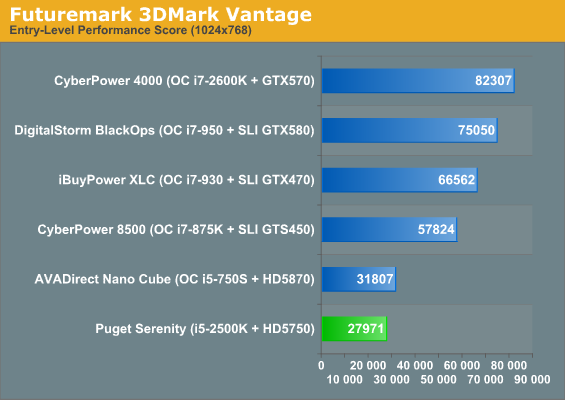
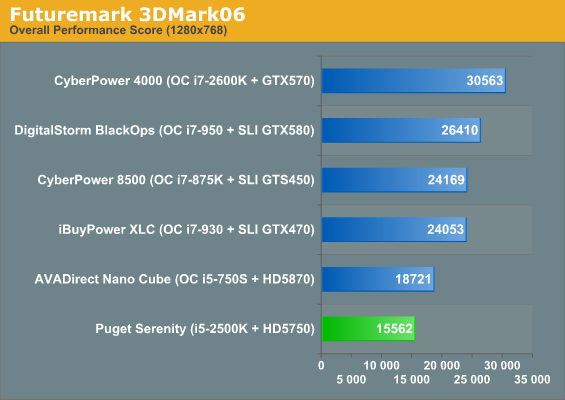

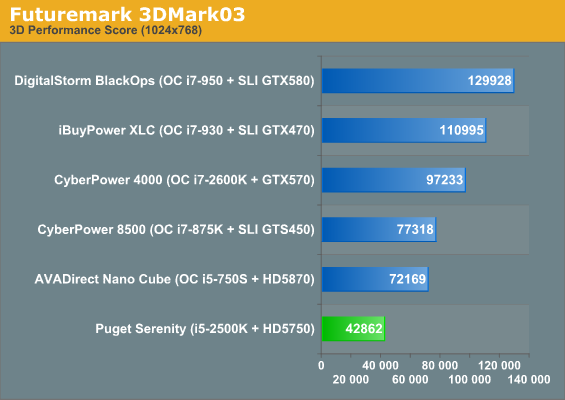
3DMark is less kind to the Puget Systems Serenity, but it still posts a strong showing and as we'll see the 5750 at its heart is for the most part able to game at 1080p. Again, remember that the Serenity is basically inaudible during gaming sessions and power consumption is remarkably low, as you'll see later. Of course, if the 5750 just doesn't cut it for you it's worth repeating that Puget Systems is working on getting a passively-cooled Radeon HD 6850 in house. It's entirely possible that by the time they can start shipping Sandy Bridge-based systems like this one again you'll actually be able to make that upgrade.










139 Comments
View All Comments
Dustin Sklavos - Thursday, February 10, 2011 - link
It's not a 5db decrease. Trust me when I say that even in the dead of night, in utter silence, you still won't hear so much as a low hum from this computer. Laptops don't get this quiet unless they're asleep.The only way you'd know the Serenity was on would be the power light.
mgl888 - Thursday, February 10, 2011 - link
Yes I kind of exaggerated there:PI wonder how much difference the foam makes in dampening the noise. I might grab some from Ebay and give it a try.
Trefugl - Thursday, February 10, 2011 - link
Foam goes quite a long way damping the airborne noise and since they chose a good (quiet) HDD they don't have to worry about structure borne noise (vibration).You really should tailor the solution to the particular problem. My personal PC was having issues with structure borne noise a few years back (due to my RAID array), so I added some vibration damping PVA sheeting to the side panels. I probably should also add some foam (to stop the sound of my SLI setup during gaming) but i just haven't gotten around to it now that my system is acceptable.
vol7ron - Thursday, February 10, 2011 - link
Agreed, solution should fit the problem.Really, when in doubt dish it out. It's easier to cater to all the noise possibilities early, rather than install everything and find out something is rattling behind the board later on. Be careful when getting a 120mm, you want to pay attention to two numbers: the db and the cfm. The decibels (db) is directly related to sound, but the cubic feet per minute (cfm) is how much air can be pushed through. If you have a fan with a high cfm, it's more likely that you can run it at a lower setting, thus reducing the actual db used.
Also, realize that the foam/filters might decrease airflow. It's sort of like how you put more ventilation behind drywall to help sound-proof noise between rooms in a house. It does reduce sound, but it also helps close off the thermo system. That means your case might build up more heat, increasing work on the fans, increasing the sounds generated -- just something to keep in mind when making sure you have good airflow set up.
oynaz - Thursday, February 10, 2011 - link
Sounds like a nice system for use in a studio.mgl888 - Thursday, February 10, 2011 - link
Pun intended?wolfman3k5 - Thursday, February 10, 2011 - link
So because Puget is not willing to just give their work away, and instead they charge money for real warranty, support, and excellent service they won't get an award? Wow! Ever heard of you get what you've paid for? In all my dealings with Puget I've been extremely satisfied. I've seen now other companies that offer 3 ~ 4 years warranty, but will rarely honor it. So what good is it then?! Dustin, grow some man hair and some common sense and write more acceptable conclusions. And Puget: stop wasting your time and money with web sites like this.Dustin Sklavos - Thursday, February 10, 2011 - link
Nobody asked them to give their work away, and actually I've been very briefly back and forth with Jon over there about the review. He disagreed with me on the pricetag and to an extent he's right, but there's still some real markup there that makes Puget Systems a tough sell compared to other boutiques.The flipside is that, as I mentioned, most other boutiques frankly just aren't producing systems as nice as this one and I think you could definitely make a case for spending up a bit and going with them. If you're willing to spend up you'll likely get a better shopping experience with them and frankly they don't seem to cut any corners on their builds, using top notch parts from day one.
Jon also argued that the one year warranty is to avoid being disingenuous: parts can go EOL and it may be difficult to even service that warranty under those circumstances. I don't disagree with him.
Unfortunately, a lot of consumers are only going to look at the bottom line: Puget's computers are more expensive and they only allow list a one year warranty on parts when everyone else has standardized on at least advertising three.
Trefugl - Thursday, February 10, 2011 - link
I'm somewhere between both sides on this.Dustin, I think it was unfair to simply list the Newegg price without pulling a comparable list price from another boutique. Yes, we as the Tech crowd could just throw something together from Newegg (tho it might be louder), but with a boutique there is always some markup to cover labor and overhead, and at least (as you said) they don't charge a lot extra to upgrade components.
Now, a roughly $1k markup is pretty high, but you're getting excellent components and a ridiculously quiet system. While the price is too high for my personal tastes, I'm not really the targeted customer - I really would never buy a mid to high end desktop from anyone, as I can always make it cheaper myself and have the knowledge and abilities to customize the case/design to suit my needs.
NCM - Thursday, February 10, 2011 - link
Dustin Writes: "Nobody asked them to give their work away."Hey, they get to set their price— and the market decides whether it sells or not. The AT readership is likely to have a disproportionate number of people who would assemble their own systems, but out in the real world many more buyers want complete solutions. We've certainly paid good money for well engineered low noise devices.
(Me, I'm still trying to get over noting in the comparo that someone sells a box called the DigitalStorm BlackOps. Are these named by 12-year-old boys or for 12-year-old boys...or both?)